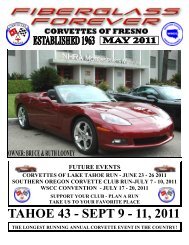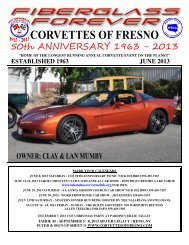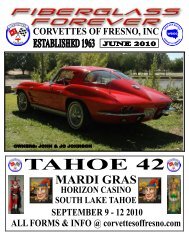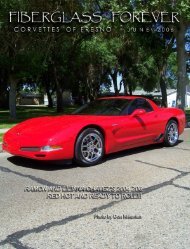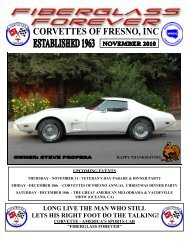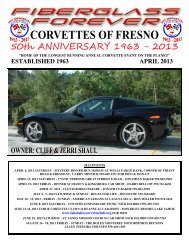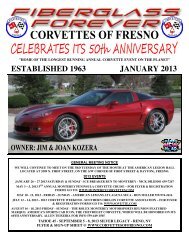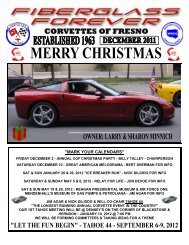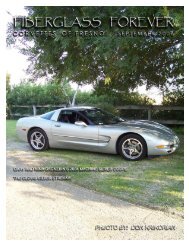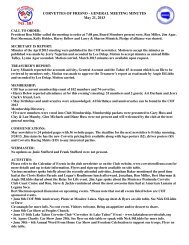corvettes of fresno - Description: Description: Description ...
corvettes of fresno - Description: Description: Description ...
corvettes of fresno - Description: Description: Description ...
You also want an ePaper? Increase the reach of your titles
YUMPU automatically turns print PDFs into web optimized ePapers that Google loves.
March<br />
June<br />
• The driving team <strong>of</strong> John Greenwood, Ron Grable, and Mike Brockman drive a Corvette to a win in its<br />
class at Sebring, and taking third place overall, the best ever showing for a Corvette at Sebring.<br />
• Corvette Corral, forerunner to Bloomington Gold, is first held, in Bloomington, Illinois.<br />
September 13<br />
• General Motors show a 266ci two-rotor Wankel-engined test Corvette at the 45th German Motor Show in<br />
Frankfurt, Germany. The car is called Corvette 2-Rotor, (code name XP-897GT) with a steel body.<br />
October 4<br />
• General Motors premieres the 390ci mid-engined Corvette Four-Rotor prototype at the Paris Automobile<br />
Salon in France. The Corvette Two-Rotor is also shown. Both use rotary engines based on Wankel<br />
technology.<br />
Although 1973 VIN's run to 34464, only 30,464 units were built; the 4,000 serial numbers<br />
between 24001 and 28000 were never used.<br />
The 1970 - 1972 Corvettes were the last to feature chrome bumpers front and rear. In 1973,<br />
due to front impact legislation requirements, the front bumper was changed to a body-colored<br />
flexible plastic. In 1974 the rear bumper followed suit.<br />
In 1973, aluminum wheels were again listed as an option. However, their inability to maintain<br />
air pressure (much like the problems which plagued the early 1963 aluminum knock <strong>of</strong>f<br />
wheels), kept them out <strong>of</strong> the hands <strong>of</strong> customers until 1976.<br />
Government mandated safety regulations that made their first appearance in 1968 became more<br />
intrusive with the introduction <strong>of</strong> the 1973 Corvette. New laws required all cars to be able to sustain<br />
a five mph impact on the front without damaging lights or other safety gear. The bumper system<br />
consisted <strong>of</strong> a injection molded urethane cover, which, due to the flex agent in the paint, was <strong>of</strong>ten<br />
a slightly different shade than the rest <strong>of</strong> the car. Also gone was the "ice cube" style grille and the<br />
fender louver, which was replaced by a rather bland and untrimmed recess.<br />
A new hood made an appearance in 1973 and the new design eliminated the need for the moveable<br />
panel that was raised to allow the windshield wipers to do their thing. The mechanism was<br />
troublesome so it probably wasn't missed.<br />
The rear window would no longer be removable. The idea was to give a more open feeling, but<br />
excessive wind buffeting meant that it was little used.<br />
Some steps were taken to make the Corvette a quieter place to drive and ride in, including the<br />
addition <strong>of</strong> sound deadening material on some inner panels, a hood pad and improved chassis<br />
mounts.




